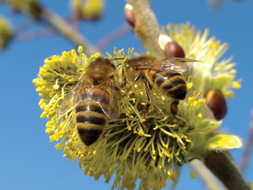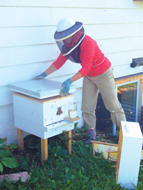Bees in Bozeman Your New Neighbors
 In the last few years, honey bees have made many headlines. To some, the plight of honey bees is just another symptom of planetary disease. Electromagnetic waves from cell phones and pesticide use are just two purported causes of the deaths of thousands of honey bees, some lost as entire hives (known commonly as Colony Collapse Disorder (CCD).
In the last few years, honey bees have made many headlines. To some, the plight of honey bees is just another symptom of planetary disease. Electromagnetic waves from cell phones and pesticide use are just two purported causes of the deaths of thousands of honey bees, some lost as entire hives (known commonly as Colony Collapse Disorder (CCD).
Alison Sweeney, a beekeeper, demonstrates how urban beekeeping is one positive light in the world of bees, pollination, and our future urban food supply.
Alison tells me about her inspiration to become an urban beekeeper. “One year we planted a whole bunch of squash plants, and did not get a good crop…and I thought it’s got to be the pollination issue.” She later discovered that a single squash blossom needs seven different visits from pollinators to produce fruit.
Alison and her husband Andy aspire to grow much of their own food. Maintaining their own pollinators created a bumper crop of pumpkins and squash last summer.
Their bungalow is on the south side of Bozeman, between West Main Street and Montana State University. On their corner lot Alison and Andy constructed vegetable beds in their boulevards, as well as filling the yard space with a chicken coop, beds for raspberries, and blackberries, planted apple and plum trees, myriad vegetable beds and bee hives.
Alison has kept honeybees for two seasons, since 2011. She describes to me a bit of a horror story with her first hive.
From the early advice she received about beekeeping, Alison did not prepare for what happened: her hive swarmed one day. A swarm is a splitting of a hive, and can be a sign of progress, of outward expansion. The hive literally splits in two, creating another group of bees. Unprepared for her first swarm, she was also alone at home.
“It sounded like an airplane…I watched out the window, ‘oh crap, oh crap, what do I do?’ Luckily they landed on one of our Caragana branches in a big cluster…” Alison reports. After a few calls to local beekeeping friends, and sorting through her options, she gathered her courage to go out and catch her swarm.
“They gorge on honey before they leave the hive, because they need to have fuel to build wax for their new home. Physiologically they aren’t supposed to be able to sting you, but I don’t buy it,” Alison smiles.
Wearing full beekeeping protection, she clipped off the branch the bees were clinging to and placed it in a plastic container and covered it with a screen. When Andy came home that evening, Alison tells me with a laugh, he began building a new home for these bees. Transferring them to their finished home, Alison noticed the bees had already been making wax in their container.
“When I caught the swarm this year, I had (another) hive box and it was much less stressful,” Alison describes.
One beekeeper cautioned the swarm might be a sign of disease and to them go. Alison felt this would be less ethical in her urban environment. She figured the hive might settle into someone’s mailbox or roof eve, so she acted to protect her neighbors from dealing with uninvited bees.
In the summer of 2012, two of her three bee hives were in her backyard. Alison’s third hive was in a rural home south of town, near Leverich Canyon. These bees did poorly, not producing any honey and hardly adding to the comb within their hive. In the summer of 2011, these bees had produced honey in her backyard. In contrast, Alison reaped the rewards of her two hives at her home, collecting over four gallons of honey.
What’s the difference? It might be as simple as an abundance of food. Alison stresses her idea that the biodiversity of flowering trees and plants in her neighborhood contribute to her bees foraging success. During the summer months, there are always different species of plants and trees in bloom, keeping the food supply relatively steady.
“Even in the fall, people want plants that are blooming; it’s beautiful to look at, but it’s convenient for the bees that people are choosing varieties that are late blooming; I think there are more of these in town,” Alison tells me.
Bee researcher Heidi Wolff and her Urban Green Bee www.urbangreenbee.com project sampled the pollen collected by bees in rural versus urban study areas in the Washington D.C. area. The urban bees collected had higher protein content pollen, as well as twice as many different pollen types, than their rural counterparts.
Urban beekeeping is a growing trend in the U.S. as well as many European cities. Chicago’s City Hall and hotel rooftops in Paris and New York City boast of robust honeybee hives producing delicious local honey.
In London, enthusiastic hobby beekeepers may have reached a threshold. The London Beekeepers Association reports concern that the city may have too many honeybees; the number of hives has almost doubled between 2008 and 2012.
The California Almond Crop: one large rural example
In the winter in California, big bee business occurs when the almond trees flower. California farmers grow almonds on about 750,000 acres in 16 counties. Millions of bees are trucked in from all over the U.S. to pollinate the almond trees.
“Now commercial beekeepers make as much money on pollination services as they do selling honey,” Alison reports. “When all the bees in the United States converge on California, they share diseases. Whatever bees have it is soon spread everywhere.”
Thousands of bee hives could not survive there year round, because almond trees dominate the landscape. This lack of biodiversity only supports bees foraging for a short window of time.
“Monoculture in itself is not sustainable. For two to three weeks in February there is a glut of food for these bees, but two weeks later there is nothing. From a pollinator perspective I think that’s the hardest thing on them. We believe GMOs play a role, pesticides and insecticides play a role, but monoculture is really detrimental,” remarks Alison.
Over time large-scale beekeepers have selected honey bees that produce less propolis — a sticky resin foraged from surrounding trees and plant resins. The bees use it to seal their hives. With less propolis in the hive, there’s also been an increase in bee pathogens. The anti-microbial, anti-viral, anti-inflammatory and anti-fungal properties of propolis and its decline in the hive suggest another weak link in individual bee and hive immunity.
“What we really should be doing is creating environments with biodiversity, where multiple crops grow. Everything is a balance; one thing takes nitrogen, another plant gives nitrogen…That’s why in town [beekeeping] works so well,” Alison says.
In March 2013, Alison updates me that her two backyard hives didn’t survive the winter. Rarely do you know why a hive doesn’t make it, she asserts. Alison guesses the different type of hive box may have made the difference. Her urban bees were in Warre hive boxes which have a bigger volume than the Langstroth boxes, giving the bees more space to keep warm. Her rural hive occupies a Langstroth box and did survive the winter.
Dr. Michelle Flenniken, an assistant research professor in the Department of Plant Sciences and Plant Pathology at MSU, recently spoke to Alison’s beekeeping group. She reports that during the almond flowering in California this year, beekeepers are experiencing significant CCD. The numbers aren’t completely dialed yet, but many beekeepers have lost upwards of half their honeybees. One beekeeper from Montana has 3,000 hives remaining out of 13,000 hives; his bees began to die off last fall.
Dr. Flenniken was not quick to agree that bees may find more reliable food sources within city boundaries. She thinks urban beekeepers treat their bees more like their cherished pets, especially since they have significantly fewer hives to care for. Dr. Flenniken also pointed out that there is a higher amount of chemical use within urban boundaries versus rural areas. In the academic world of bee research, the question of pesticides use is being studied.
Researchers have found that two types of pesticides, neonicotinoids and coumaphos, are interfering with bees ability to learn and remember, causing a decreased ability for the bees to forage. Experiments revealed that exposure was also lowering brain activity, especially when the two pesticides were used in combination. It’s interesting to note that in 2005 two things began: CCD became a phenomenon and neonicotinoids and coumaphos pesticides were used in greater amounts.
The growth of Community Supported Agriculture (CSA) in the Gallatin Valley and across the U.S. is rooting people to their farmlands. Backyard vegetable beds and Community Gardens are also on the rise. If honeybees are out of the equation, then fresh, healthy foods will also be. It makes good sense to welcome bees to our urban landscape.
Liz Allen’s background in forest advocacy continues to fire her curiosity about the natural world. She practices massage and runs Focus Massage Therapy. She can be reached at lizallen32@gmail.com